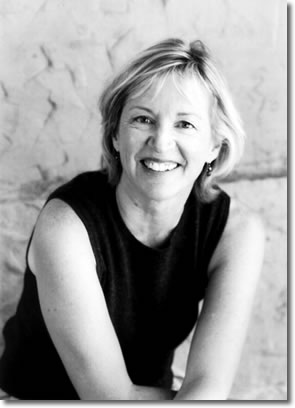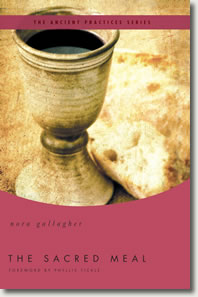The Sacred Meal by Nora Gallagher
A Deep and Personal Look at the Power and Meaning of Holy Communion
In her foreword to Nora Gallagher's book The Sacred Meal, Phyllis Tickle writes, "Communion is where we join, one with another in God, as in no other act and no other practice within this life; and the joining is exquisite in its joys and its sorrows, its nurtures and its costs."
This sharing of bread and wine at the Communion table transforms and transports us in ways that we may find ineffable. How then can we understand and articulate the power and profundity of this ancient practice that began at Jesus' Last Supper? We could do no better, as we search for a guide, than to look to Nora Gallagher.
A well-known and noted writer of both fiction and memoirs (Things Seen and Unseen: A Year Lived in Faith and Practicing Resurrection), Gallagher submits that her best qualifications are grounded in participation. She has served both the bread and the wine, and has partaken of the Eucharist countless times in all sorts of settings, it being the only spiritual practice that has been constantly part of her life over the years.
The Sacred Meal allows us to consider, with Gallagher, what it is that brings her back, time and again, to the Communion table, and in so doing helps us understand for ourselves the profound import of this communal and very personal experience where we are conjoined with the holy. explorefaith asked Gallagher about her approach to the Eucharist as a writer and as a Christian committed to this one practice, above any other.
 explorefaith: Holy Communion is considered a sacrament of the church. Yet you talk about the Eucharist as a practice—one that, of all the church practices, you will never give up. What is it about practicing Holy Communion that touches you so deeply? Do you think it is that sacramental quality that makes it so special?
explorefaith: Holy Communion is considered a sacrament of the church. Yet you talk about the Eucharist as a practice—one that, of all the church practices, you will never give up. What is it about practicing Holy Communion that touches you so deeply? Do you think it is that sacramental quality that makes it so special?
Nora Gallagher: When Phyllis Tickle, the editor of this Ancient Practices series, asked me to write a book about Communion as a practice, I was surprised, because I hadn’t thought of it as one. I, too, had thought of Communion only as a sacrament. Then I thought about what a practice is: a place where the heart and mind are trained in wrestling, not with doubt, but with illusion. What is life-giving is often hidden or seems to be hidden from us.
We live in a world where we mistake riches for sustenance, a new purse (you fill in the blank) for food, power over others for our own empowerment. It is often harder to do good than to do evil. We need all the help we can get. A practice, I think, is a way to keep a door open to the holy. And while I have backslid on about every other practice I have attempted—daily prayer, meditation, Sabbath—I regularly keep Communion.
It is this sacramental quality that keeps drawing me back. It has so little functional “worth” by the world’s standards. It’s just an odd, mysterious, hard-to-understand ritual. But it’s about something very deep and ancient that people have been re-enacting for thousands of years.
explorefaith: For some people who are unfamiliar with the traditions of the church, the words of communion may seem strange, even a bit creepy. What does the language of eating the body and drinking the blood of Christ mean to you?
Nora Gallagher: I was horrified the first time I encountered the “body and blood” language in a Roman Catholic Church I visited with a friend. Recent historical research and thinking about that language is well worth reading, because there is a lot of speculation that the creepy eating of flesh and blood, was not original to Jesus. (I spend some time in The Sacred Meal briefly introducing the reader to some of the more recent scholarship on this.) Lately, I have been thinking two things: If the language of body and blood really came from Jesus, he may have meant something like this: It’s so important to do this together, to gather and eat together, and encounter the holy together, that it’s as important as food. It’s like food! You can’t live without it! And I am food to you. I mean to be food for you. I am willing to be always food for you.
The second image, that I love, is from a woman bishop who recently preached a sermon about this language. I didn’t hear the sermon, but friends told me she had been thinking that the body and blood are like the food that a mother gives her fetus in utero. You don’t get more graphic or more intimate than that: it’s the mother’s blood and body that’s feeding that fetus. If we think of Jesus as feeding us that way: as being so completely involved with our well-being that he’s like a mother preparing a fetus for birth, that’s an image I understand.
explorefaith: We are called to remember Jesus at communion. What else does the Eucharist call us to do?
Nora Gallagher: The word “practice” derives from the Greek for “practical” or “concerned with action.” All practices are meant, I think, not to be places where you stay and take a nap, but to lead somewhere, out into the world. A wonderful line from a priest, Ion Bria, is “the liturgy after the liturgy.” We’ve gathered at the table. Something has happened to the bread and wine, as the poet Mary Oliver says: “What now?”
explorefaith: Your book often references the soup kitchen at your church. How did working in the soup kitchen help you to better understand the meaning of Holy Communion?
Nora Gallagher: After I began not only serving food to homeless men and women, but eating at the tables in our parish hall with them, I understood much more what Jesus was doing when he sat at a table with outcasts. He was practicing, as John Dominic Crossan has said, commensality: “To know with whom people eat,” Crossan points out, “is to be shown a map to social hierarchy.Jesus made no distinctions or discriminations; his was the open table.” I began to see the connection between the open table in the soup kitchen and the open table at the altar. The altar celebration was meant to be a reflection, a deepening, maybe a mirror of that other, more messy table. The one made no sense without the other.
explorefaith: If you were to ask most people to describe Communion, they would likely focus on the bread and wine. Your discussion involves the waiting, the receiving and afterward. Can you explain why those three are all integral parts of the communion experience?
Nora Gallagher: Everyone has different ways of approaching Communion, but I have found that there are those three parts for me. During the “waiting,” I seem to be living in my head with all the anxiety, regret, guilt and distraction that resides there. It’s like the baggage you carry when traveling. I carry all of that with me toward the altar. Once at the altar, I am asked, I think, to just open my hands. That’s it. Receive. It’s dangerous to open your hands. You don’t know what will end up in them. This had to be one of the smartest things Jesus ever did. He must have thought, How can I make them step into the unknown? How can I get them to let in a little surprise? I know what I’ll do: I’ll figure out a way for them to put their hands out in front of them, empty.
explorefaith: Much of your book consists of personal stories of people you’ve known. Do you find that only in the personal can we get a glimpse of the power Communion holds?
Nora Gallagher: I am wary of the word “only.” But for me, faith is all about experience. The living out of faith, the seeing indications of the holy in the world, encounters with others, hearing other people’s stories. Driving along in the snow with the headlights illuminating just the next patch of ground. This is what sticks to me.
Help explorefaith when you purchase THE SACRED MEAL or any other item from amazon.com.
